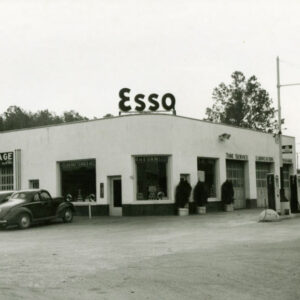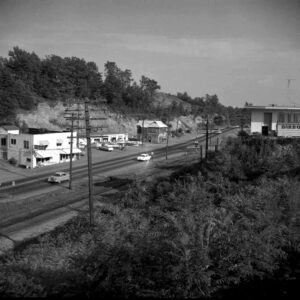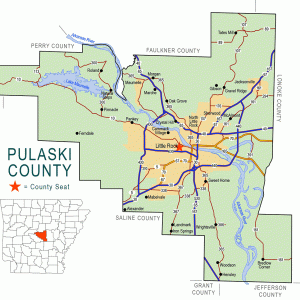calsfoundation@cals.org
Levy (Pulaski County)
Levy, which is now a part of North Little Rock (Pulaski County), was named for a prominent Jewish merchant. The community originated as a campground for farmers and drovers traveling the Fort Smith (Sebastian County) road to markets in Little Rock (Pulaski County). In 1892, Levy founder Ernest Stanley opened a general store near the campground north of Argenta. A settlement of industrious working-class people emerged with the opening of Camp Pike in 1917. War preparations at Camp Joseph T. Robinson in 1940 further fueled Levy’s growth, and the Levy Day political rally put it on the map in the 1950s. A municipality from 1917 to 1946, Levy has retained its identity into the twenty-first century. Today, a growing Latino population, plus nearby Camp Robinson and resident associations, contribute to Levy’s economic and cultural vitality.
Ernest Stanley, who became Levy’s first postmaster in 1905, named the new station after dry-goods merchant Morris Levy. Historian Evelyn Eubank wrote that Levy lent Stanley $50 and credit to start his store. Walter Stanley, a grocer and one of Ernest’s brothers, said the community would have been called Stanley if that name had not already existed elsewhere. Brothers William F. “Flake” Stanley and Oscar Stanley opened Stanley Hardware in 1901. The Stanleys, Dr. James F. Pairet’s drugstore, and Abraham B. Kyzer’s grocery formed the nucleus of the business district.
Levy incorporated as a municipality on May 7, 1917. Voters elected a mayor, city recorder, and five aldermen on August 7, 1917. The town of a few hundred people was bounded by today’s Pershing Boulevard on the south, 38th Street on the north, Division Street on the west, and Orange Street on the east. There were two grammar schools: Levy and Hillside. At the town’s northern border was Thomas Cemetery, adjacent to Edgewood Cemetery, established later in 1923. The council first met on August 13, 1917, and soon imposed a speed limit of ten miles per hour. Mary Bottomley, who moved there in 1918, recalled dirt streets, the Stanley stores, and “a cold drink stand and a bowling alley.” Flake Stanley, the first of eight mayors, served until 1925. By 1940, Levy’s population was 1,400, and it rapidly grew with military expansion at Camp Robinson. The Arkansas Gazette on August 19, 1941, estimated a population of 2,000.
Levy’s treasury never adequately addressed dark and unpaved streets, poor drainage, substandard bridges, and unreliable fire protection. Housing shortages and traffic congestion also plagued the town. Nonetheless, Levy annexed an area between Camp Robinson Road and Orange Street up to 45th Street in 1942 and built a city hall at the site of the present Levy fire station. James H. Fretwell was Levy’s last and longest-serving mayor. Following Levy’s annexation by North Little Rock in 1946, downtown Levy remained vibrant, with Bob Evans’s Esso, Huggins Drug, the Ashley Building, Wasson Home and Auto, George’s Dry Cleaners, Hill Drug, Venable Lumber, Tolliver’s Gulf Station, King’s Barbershop, Economy Furniture, Art’s Marine, cafes, beauty shops, and grocery stores. The Scenic Drive-In movie theater, which closed in 1961, and Jim’s Roller Rink in the 1950s and 1960s were attractions, as was the Spot drive-in restaurant from 1964 to 1997.
Doyle Venable’s lumber company opened in 1951 and launched Levy’s greatest tradition—an all-day paint sale, spiced with musical entertainment. “Levy Day” became one of Arkansas’s premier political rallies after Venable—Levy’s “unofficial mayor”—invited candidates in 1954. The Sertoma Club continued Levy Day until 2006.
Construction of Interstate 40 in 1962 cut through downtown Levy, and the business center shifted north on Camp Robinson Road, where the Levy Shopping Center and Walmart Inc. opened in 1967. Levy grew well beyond its original boundaries, stretching north of 47th Street. North Heights Elementary opened in 1953, and the City of North Little Rock added a recreation center there in 1971. Levy Elementary School closed in 1985 after holding classes for seventy-eight years. In the 1990s, Levy residents lobbied for more street lights, street repairs, and a police substation.
The population of the Levy area grew only 1.1 percent from 1990 to 2010, according to the U.S. Census Bureau, and that growth was due to a rising Latino population. Figures from census tracts in Levy, compiled by the North Little Rock Community Planning Department and Metroplan, show that Latinos were twelve percent of the overall Levy population of almost 12,000 in 2010. That compares with about five percent of Levy population in 2000 and 1.2 percent in 1990.
For additional information:
Adams, Walter M.North Little Rock, the Unique City: A History. Little Rock: August House, 1986.
Bradburn, Cary.On the Opposite Shore: The Making of North Little Rock. Marceline, MO: Walsworth Publishing Company, 2004.
Levy Reference File. North Little Rock History Commission, North Little Rock, Arkansas.
Levy Town Council Minutes. North Little Rock History Commission, North Little Rock, Arkansas.
Cary Bradburn
North Little Rock History Commission
 Pulaski County
Pulaski County Evans Esso
Evans Esso  Levy Street Scene
Levy Street Scene  MoPac Wreck
MoPac Wreck  Pulaski County Map
Pulaski County Map 




Comments
No comments on this entry yet.